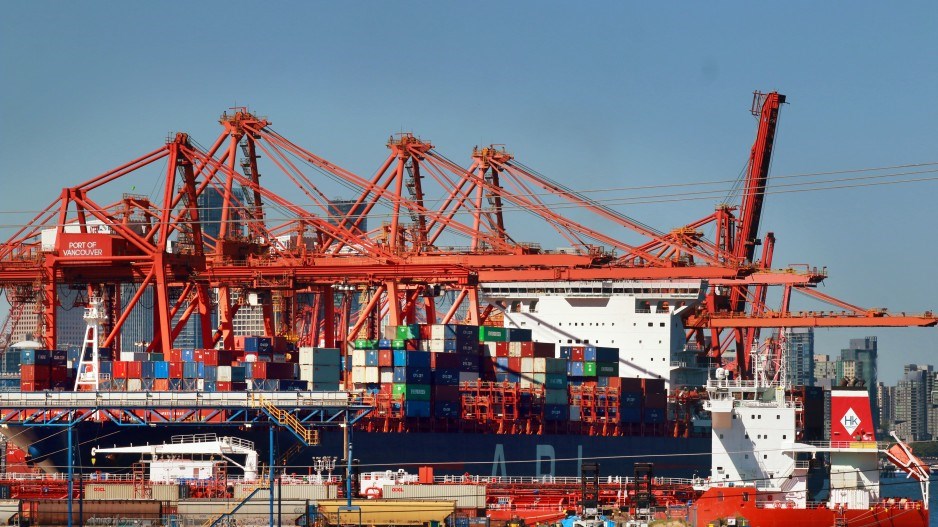The amount of container cargo handled by B.C.’s major ports continues to increase, but concerns raised by global shipping lines and international economists should be triggering storm warnings along B.C.’s Asia-Pacific Gateway trade corridor.
Mid-year cargo numbers released recently showed container cargo volumes through the Port of Vancouver up 5% to a record 1.64 million 20-foot equivalent units [TEUs] and up 16% through the Port of Prince Rupert to 591,335 TEUs compared with 2017’s first six months.
The profiles of both ports continue to rise in the global container sector as cargo flow has remained buoyant, but collateral damage from tariffs and U.S.-China sabre rattling threatens to stall transpacific trade growth.
Vancouver recently graduated into the list of the world’s top 50 container ports as compiled by the U.S.-based Journal of Commerce (JoC). Its 10.9% increase to 3.25 million TEUs handled in 2017 elevated it to No. 47 in the JoC rankings.
Prince Rupert has a long way to go to break into the top 50, but it remains one of North America’s fastest-growing container shipping ports.
Shanghai, which handled 40.23 million TEUs in 2017, remains No. 1 on JoC’s list.
Aside from Vancouver other North American ports on the list are No. 17 Los Angeles [9.34 million TEUs], No. 22 Long Beach [7.54 million TEUs], No. 23 New York/New Jersey [6.71 million TEUs] and No. 44 Northwest Seaport Alliance (Seattle/Tacoma) [3.7 million TEUs].
In an interview with Business in Vancouver following the release of Vancouver’s mid-year container cargo numbers, Robin Silvester, president and CEO of the Vancouver Fraser Port Authority, noted the increase reflected ongoing strength in imports and exports through the Port of Vancouver.
But he expressed frustration over delays in environmental approval for transportation infrastructure projects and the rapid disappearance of Metro Vancouver industrial land suitable for expanding port operations.
Concerns over infrastructure constraints are shared by the port’s customers.
In an interview with BIV in August, Chris Daniells, commercial director for China Navigation Co. Ltd. (CNCo), pointed to the limited lay-down space for break-bulk cargo his company faces in Vancouver, especially when it comes to steel shipments.
CNCo recently opened its North American headquarters in Vancouver. The merchant shipping company is owned by U.K.-based John Swire & Sons Ltd. and is part of the Swire group of companies, a multinational conglomerate involved in aviation, marine services, property and beverage distribution. Swire, whose market cap is estimated at US$69.4 billion, posted 2017 revenue of US$29.3 billion.
Daniells added that uncertainty generated by the ongoing China-U.S. trade dispute is a major worry for global shipping companies.
Uncertainty in the outlook for world trade is also in the air.
In an August 28 briefing note, Oxford Economics analyst Adam Slater pointed to several indicators that “suggest the world trade boom is over.” The U.K.-based economic research company’s lead economist said those indicators could cut the current 3% trade growth, which is already well below 2017’s year-on-year 6%, to around 1% by year’s end.
Top container carriers, meanwhile, are grappling with other challenges.
Maersk (CPH:MAERSK-B), the world’s largest containerized cargo shipping company, noted in its second-quarter 2018 financials that, while global container trade grew by 4% compared with the same quarter in 2017, container traffic on east-west trade routes remained soft. It warned that U.S.-bound container imports from China could be cut by up to 4% and Chinese imports of U.S. goods could be reduced by around 6% as a result of a ramped-up tariff and trade war between the two countries.
Maersk’s share price was among the negative freight-based indicators cited by Oxford.
A 43% spike in the price of bunker fuel prices has also seriously eroded margins for container carriers in a sector that continues to struggle with overcapacity and weak freight rates.
Hapag-Lloyd (ETR:HLAG), the world’s fifth-largest container cargo carrier, posted a loss of 100.9 million euros in 2018’s first half, compared with its 42.7 million euro loss during the same period in 2017.
Company CEO Rolf Habben Jansen said in a statement accompanying Hapag-Lloyd’s mid-year financials that rising fuel costs, higher charter rates and a slower-than-expected recovery of freight rates were key factors affecting results in 2018’s first six months.
Meanwhile, Oxford’s Q3 2018 Global Risk Survey found growing pessimism about the global economy, noting that trade war fears “dominate the survey to a greater extent than for any other risk since the survey’s inception.”
@timothyrenshaw




